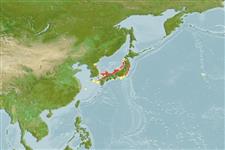>
Perciformes/Zoarcoidei (Eelpouts and pricklebacks) >
Lumpenidae (Eel pricklebacks)
Etymology: Xenolumpenus: Name from Greek, Xeno (= strange), and Latinized Danish, lumpenus (type genus of the subfamily Lumpeninae), for the elongated pectoral, pelvic and anal fin rays; longipterus: Name from Latin, longus for long and Latinized Greek pteron for wing; referring to the elongate pectoral fins.
Environment: milieu / climate zone / depth range / distribution range
Ecologie
marien benthopelagisch; diepte 167 - 300 m (Ref. 84251). Temperate
Northwest Pacific: Japan.
Grootte / Gewicht / Leeftijd
Maturity: Lm ? range ? - ? cm
Max length : 11.5 cm SL (female)
Korte beschrijving
Determinatiesleutels | Morfologie | Morfometrie
Dorsale stekels (totaal) : 46 - 48; Anale stekels: 2; Anale zachte stralen: 30; Wervels: 52 - 54. This species is distinguished by having the following characters: DXLVI-XLVIII; A II,28-30; membrane extremely incised, rays elongate; 11 pectoral-fin rays, including 3 ventralmost rays free from others and the longest ray 36.5-40.2% SL; pelvic fin rays elongate, membrane well-incised, and rays unbranched; 2 mandibular pores; 1 or 2 large black blotches on pectoral fin; black ocellus on caudal fin (Ref. 84251).
The specimens have well-developed ovaries containing ca. 1.5 mm diameter eggs, suggesting the spawning of the species occurs in autumn (Ref. 84251).
Levenscyclus en paargedrag
Maturiteit | Voortplanting | Paaien | Eieren | Fecunditeit | Larven
Shinohara, G. and M. Yabe, 2009. A new genus and species of prickleback (Perciformes: Stichaeidae) from Japan. Ichthyol Res (2009)56:394-399. (Ref. 84251)
Status op de Rode Lijst van het IUCN (Ref. 130435: Version 2024-1)
Gevaar voor de mens
Harmless
Gebruik door de mens
Tools
Speciale rapporten
Download XML
Internetbronnen
Estimates based on models
Preferred temperature (Ref.
123201): 2.2 - 17.7, mean 12.3 °C (based on 12 cells).
Fylogenetische diversiteitsindex (Ref.
82804): PD
50 = 1.0000 [Uniqueness, from 0.5 = low to 2.0 = high].
Bayesian length-weight: a=0.00129 (0.00050 - 0.00329), b=2.99 (2.77 - 3.21), in cm total length, based on LWR estimates for this (Sub)family-body shape (Ref.
93245).
Trofisch niveau (Ref.
69278): 3.2 ±0.4 se; based on size and trophs of closest relatives
Weerstandsvermogen (Ref.
120179): Hoog, minimale populatieverdubbelingstijd minder dan 15 maanden (Preliminary K or Fecundity.).
Fishing Vulnerability (Ref.
59153): Low vulnerability (10 of 100).
